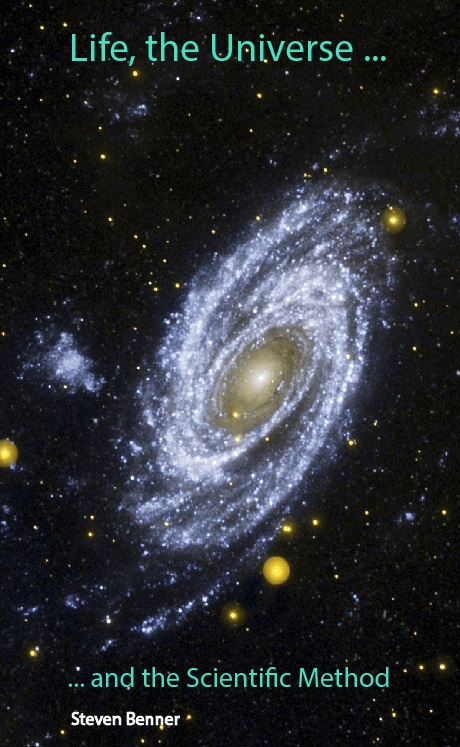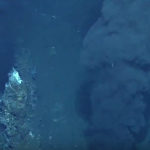Cite as: Benner, S. A. (2021) “Universal Theory of Life, a debate”. Primordial Scoop, 2021, e0911. https://doi.org/10.52400/QCFO1730
This Single Scoop initiates a back-and-forth between people interested in the quest for a universal theory of life. One starting point is a book by Carol Cleland having exactly this title, published in 2019 [1].
This discussion is funded in part by the NSF, which is also supporting laboratory research in Florida and Texas to create cell-based chemical systems capable of Darwinian evolution. Distinctive in our research is that the “life” (not to beg the question) being synthesized in the lab must exploit informational biopolymers that differ in molecular structure from the standard DNA that we share with all of our planetary companions (as far as we know).
My own position was detailed in the book Life, the Universe, and the Scientific Method [2], published a decade earlier. There, I combined the pragmatism of Van Quine with the realism of Paul Feyerabend to observe that definitions tell us more about the definer than the defined.
Yet, if we are to understand life to a level necessary to pragmatically search for life in the cosmos, or to instruct research to create new examples of life in the lab, we must understand what we mean by “life”.
And so we descend into the thicket surrounding the “definition of life problem”.
In Quest, Carol used 49 pages to argue that life cannot be defined. Much of that chapter repeats objections that she and others have raised previously, for which we have no quarrel. We are not interested in a circular dictionary definition of life. Nor do we seek a “list definition” of life. Any set of necessary and/or sufficient conditions proffered before a system may be considered “life” is likely to be no more than a list of what human definers think is important in the one example of life that we know. Here on Earth, all of the life that we know arose from a single ancestor.
Nor do we much care about Aristotle’s view of life. Aristotle missed what is important in biological reproduction, which includes errors where the errors are themselves reproducible. And we agree with Carol that too many biologists remain tethered to Aristotelian ideas, even though they might not appreciate this.
Rather, we want to know what life is, in its essence, as a universal. We want an understanding of life that would be shared by scientists on Vulcan or Kronos, just as all scientists from all three planets would agree that a molecule of water is “defined” as a molecule built from two atoms of hydrogen and one atom of oxygen.
Life the Universe also sought to avoid traps that bedevil much recent literature on this matter. Much of that literature confuses “life” as a universal with “alive” as an adjective; we are not so confused. Nor was Life the Universe interested in borderline cases (for example, are prions life?). Nor does Life the Universe spend time confirming the Ellingtonism that life is chemistry “all of the way down”; it obviously is.
For convenience, our current research also sets aside the need for life to be self-sustaining as a system. The systems properties of life, and how they manage self-sustenance, deserve a book of their own.
Likely be argued in Single Scoops to follow, Life the Universe advanced the discussion in these ways:
(a) Making no effort to define life, Life the Universe developed a different concept, a “definition-theory” of life. This neologism recognizes that any discussion of “life as a universal” must be placed within a broader construct, a theory that has consequences beyond and outside the “life” phenomenon. Philosophers seeking a similar (but not identical) concept from classical philosophy might look to “theoretical identity statements” [3].
(b) Life the Universe considered “properties that we value” in living systems. This human-centric concept requires a pairing of behaviors of accessible systems that we consider to be living with analogous behaviors in systems that we consider to be non-living. The archetypal behavior pair is (i) the behavior “devolution to tar”, which is the outcome of applying energy to an organic system considered to be non-life, versus (ii) the behavior “creating more of itself”, which is the outcome of applying energy to an organic system considered to be life (it).
(c) Life the Universe then asserts as a theoretical proposition that organic systems can come to acquire properties that we value in living systems only by a process of Darwinian evolution. Life the Universe offers a minimalist concept of such evolution, removing “self sustainability” to require only (a) replication, (b) with errors, where (c) the errors are themselves replicable. As an observable, (a) and (b) are frequent in chemical systems, ranging from crystallizations to combustion. Scarce is (c).
From this comes a directive for those seeking to understand the origin of life: We must find the exception to the rule that a non-living system devolves to tar when having access to energy. That non-life system must instead generate a system that (a) replicates (b) with errors, where (c) the errors are themselves replicable.
Finally, Life the Universe dismisses the common complaint that this definition-theory is not “operational”. This complaint premises that NASA missions cannot wait around long enough to see actual evolution. Chemical theory is adequate to examine molecules within a system to determine whether or not that system can support evolution, without waiting for it to evolve. From this comes an “agnostic life finder”; ALF is described elsewhere on this blog [4].
Quest leaves untouched this framework for understanding life. And so the proposition stands resolved:
The difference between systems that are life and systems that are not life is that the former have a mechanism for reproduction, with errors, where the errors are themselves reproducible, while the latter do not.
From this comes a directive for searching for life in the cosmos, as well as a guide for making synthetic life in the laboratory. According to this definition theory, we are not just looking for replicators. Nor replicators with errors. But replicators whose errors are replicable.
[1] Cleland, C. E. (2019) The Quest for A Universal Theory of Life. Cambridge, Cambridge University Press. 245 pp.
[2] Benner, S. A. (2009) Life, the Universe and the Scientific Method. Gainesville FL, FfAME Press, 312 pp.
[3] Beebee, H., Sabbarton-Leary, B. (2010) The Semantics and Metaphysics of Natural Kinds. New York, Routledge, 250 pp.
[4] https://primordialscoop.org/2021/02/11/how-the-agnostic-life-finder-alf-searches-for-life-on-mars/




I am an admirer of Steve’s scientific work, and as he notes, we agree on many issues pertaining to understanding the nature and origin of life. But I have long been puzzled by why he wants to coin a new term “definition-theory” for explaining the nature of life. To my philosophical ears, it sounds as if Steve wants to have his proverbial cake and eat it too. As explained below, the expression “definition-theory” is at best an oxymoron, and hence more confusing than illuminating.
As I argue in Chapters 2 and 3 of The Quest for a Universal Theory of Life (2019), definitions and scientific theories are very different sorts of logico-linguistic devices. Definitions dissect the concepts associated with general terms in a natural language into other (ideally, better understood) concepts. Definitions cannot go beyond human concepts and tell us about the nature of mind-independent, natural categories. Yet Steve insists that he is not interested in an analysis of our current concept of life: he wants to know what life truly is, independently of what we happen to think it is based on our very limited experience with a single kind of life, namely, familiar Earth life.
How is a “definition-theory” supposed to be better at achieving this than a scientific theory of life? Steve never tells us. Is it the fact that (as discussed in Ch. 2 of my book) the most informative definitions provide necessary and sufficient conditions for the application of the terms that they define whereas scientific theories don’t do this for the natural kinds that they—note: the change in terminology—subsume?
To the extent that Steve likens a definition-theory to (what philosophers call) a “theoretical identity statement” this seems to be what he has in mind. As originally construed, theoretical identity statements were supposed to supply necessary and sufficient conditions—derived from scientific investigations vs. conceptual analysis—for the natural kinds that they subsume. But as discussed below, and in Ch. 3 of my book, theoretical identity statements are misnamed; they don’t actually do this. This may explain why Steve cautions that a definition-theory is not “identical” to a theoretical identity statement. But if this is the case, then how does it differ from a theoretical identity statement, and what is the point of appending the term “definition” to “theory”? Steve never says.
Steve says that we want an understanding of life that resembles our current scientific understanding of water. In this context, he says that “a molecule of water is ‘defined’ as a molecule built from two atoms of hydrogen and one atom of water”. There are several problems with this explication of the “essence” of water.
First, Steve’s account is not about the essence of the natural kind water, which is the familiar watery stuff found in lakes and water bottles. It is an account of the elemental composition of a single “molecule” of water. Molecules are not natural kinds. Like the elements of the periodic table, they are theoretical kinds, part of modern molecular theory. The challenge for a successful scientific theory of water (qua natural kind) is to explain the distinctive characteristics of the familiar watery stuff in terms of molecular theory. Water has distinctive macroscopic characteristics, such as, for example, expanding when frozen, remaining a liquid over a wide range of temperatures, and being a good solvent, which distinguish it from other material substances. Purified water also has a unique triple point. In successfully explaining these and other observable characteristics of water, molecular theory can be said to capture the “essence” of water.
Second, molecular theory doesn’t (as Steve’s tacit identification of water with a molecule suggests) “identify” the watery stuff in lakes and water bottles with molecules of H2O. A single molecule of water doesn’t expand when frozen or remain a liquid over a wide range of temperatures. It doesn’t have a triple point either. Moreover, the purest samples of water aren’t composed of just H2O molecules. When H2O molecules combine they dissociate into ions (H+, OH-, and H3O+). In addition, H2O molecules form complex molecular structures, dimers and trimers, produced by weak hydrogen bonds, which are the source of some of the distinctive macroscopic properties of the familiar watery stuff of human experience, e.g., expanding when frozen and being a good solvent. The point is current chemical theory doesn’t provide necessary and sufficient conditions for the natural kind water in terms of being a molecule of H20 or being composed of just H2O molecules. It provides a complex theoretical framework in which the distinctive properties of the watery stuff of human experience are successfully explained by being composed mostly (but not exclusively) of molecules of H2O.
In short, as the example of the natural kind water illustrates, scientific theories do not supply necessary and sufficient conditions for the natural kinds that they explicate. So, why append the term ‘definition’ to ‘theory’?
Perhaps the answer to this question is to be found in Steve’s “definition-theory” of life, which he encapsulates in a single italicized sentence: “The difference between systems that are life and systems that are not life is that the former have a mechanism for reproduction with errors, where the errors are themselves reproducible, while the latter do not.”
This is an attractive proposal. But it resembles a definition only in being very short; theories are more complex, consisting of sets of fundamental principles or laws (e.g., Newton’s 3 laws of motion) and basic theoretical concepts (mass, force, inertia). Moreover, this statement seems inconsistent with Steve’s claim that “life is chemistry all the way down” since systems of this sort have been implemented on digital computers. Of course, the latter problem could be remedied by appending the term ‘chemical’ to “system”. But this, in turn, gives rise to the question of mechanism: What sort of “mechanisms” count here? Will any physical mechanism work, or must it be chemical, and if so, will any chemical mechanism (for reproduction with errors that are themselves reproducible work), or does life require a special kind of chemical mechanism? These are the sorts of question that can only be answered by a far more complex theoretical apparatus than the vague statement that Steve provides. There are other issues too, such as the question of whether his “theory-definition” can (in analogy with the case of water) explain “hallmarks” of life, such as its capacity to sustain itself as a system. In short, I don’t see how Steve’s vague definition-theory of life is helpful in the absence of a theory of life, especially since we currently lack such a theory.
Perhaps, what Steve has in mind is a promising, albeit very vague, preliminary principle for a future theory of life. But if this is so, why call it a “definition”-theory of life?
Cleland, C. E. (2019) The Quest for A Universal Theory of Life. Cambridge, Cambridge University Press.